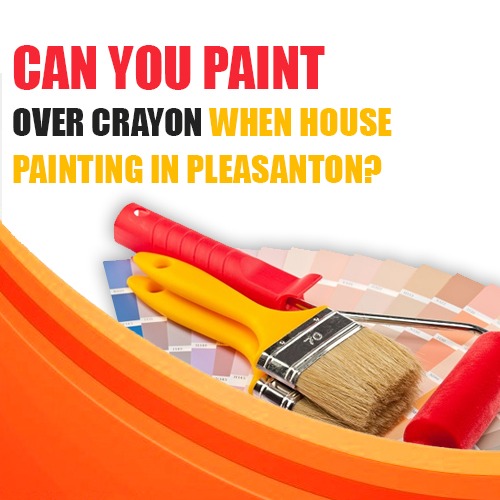If you are house painting in Pleasanton, you know nothing is more annoying than dealing with crayon marks on the wall. No matter how perfect you are as a parent or caregiver, kids are kids, especially toddlers – and a clean, spotless (and newly-painted) wall is sure a magnet for them to become a budding Picasso.
The question is, can you paint over crayon marks? The bad news is, unfortunately, painting over them will do you no good. Crayons have a wax-resist effect. Using paint alone will not work to cover crayon marks because once the paint dries – even if you have applied layers and layers of paint over crayon – the crayon wax will displace the paint and appear again.
However, you can get rid of the kiddie artwork by removing them from your painted walls. These solutions are relatively simple to do, and most of the materials are also easily obtainable. In fact, some of the procedures are quick and easy. After cleaning, it is possible also to apply a primer (often several coats of it) and then finally paint the affected surface.
- WD-40
WD 40 is an automotive lubricant that is often recommended by crayon manufacturers for removing crayon marks. This works excellently to remove crayon marks on painted walls. Simply spray a little of the WD-40 on a clean cloth. Then wipe the solution over the crayon marks. You can also spray the WD-40 directly onto the crayon marks. For crayons that are older or more stubborn to remove, more effort may be needed. If you want a less messy approach, you can also buy WD-40 No-Mess Pen instead of the regular WD-40 spray. The product leaves an oily residue and this will need to be washed off of your painted walls after the crayon marks are gone. Remember not to rub too hard while cleaning the crayon marks or you may damage the paint on the surface. - Baking soda
Don’t panic when your child has added some original crayon masterpiece to your painted walls. Just get a damp rag, dip it in some baking soda, and then gently and lightly scrub the marks. The crayon marks will almost instantly come off. - Toothpaste
Use regular toothpaste (not gel toothpaste) and a rag or scruff brush on the crayon marks. Squirt the toothpaste directly onto the wall and begin to scrub gently against the marks. Rinse the wall afterwards. - Erasers
Try these pencil erasers in removing the crayon marks. Clean any residues left from the erasing. Your walls will go back to a clean slate. - Steel wool
Steel wool is not only for washing pots and pans, but it can also be an effective crayon marks remover. Using this material, skim the surface and make straight strokes in one direction (instead of scrubbing the wall in a circular motion). Your walls will be clean in a matter of time. Gently do this or you will scrape any outer coating of paint on the walls. - Vinegar
Soak an old, unused toothbrush in undiluted vinegar, and then start scrubbing it on crayon marks. Since a crayon is made of wax, and wax is oil-based, vinegar will cut through most of the oil.
After you are through cleaning, and the walls are completely dried, inspect the walls to see if there are any waxy/oily marks left.
There are oil-based stains that really need to be addressed with paint. Although crayon is also an oil-based stain, it may or may not require painting. Try the cleaning methods mentioned above, and chances are all will be fine. But in case a crayon mark has been cleaned but still leaves a few stubborn oily stains that require painting, here are some tips:
- If there are oily marks remaining, apply a primer over it. Make sure to use a quality primer. For walls coated with latex (water-based) paints, use a latex-based primer, or use oil-based primers for walls coated with an oil-based paint. Normally, latex-based primers are applied on drywall, while oil-based counterparts are used on wood walls.
- Allow the primer to dry completely, for at least four hours. Check every now and then to see if the oily marks have seeped through the primer. If the marks are still visible, apply another coat of primer and let it dry again.
- After the primer has been dried and the oily marks have almost disappeared, now it’s time to apply a fresh coat of paint.
In case you have accidentally scraped an outer coat of paint while trying to get rid of the crayon marks, here’s how you would to get rid of those unsightly marks:
- Sand or scrape the area lightly to remove any loose paint and prepare the surface.
- Using a putty knife, add a coat of drywall compound on each area that has been scraped. You can also use a thin coat of spackling paste, and let it dry.
- Finish the small drywall scratch by sanding. This will create a smooth surface. Be sure that the area is completely sanded and free of sand residues before applying primer, paint, or drywall texture.
- Applying a primer before painting is not necessary but is highly recommended to ensure that the paint adheres well on the surface.
- After the primer is completely dried, apply a fresh coat of paint.
It is good t allow children to dabble in artwork because it gives them a sense of creativity. But when they leave crayon marks on walls, don’t lose your cool. Follow these simple steps using easy-to-obtain items for removing crayon marks and re-applying a fresh coat of paint – and your walls will be clean and new again in no time if you are house painting in Pleasanton.

